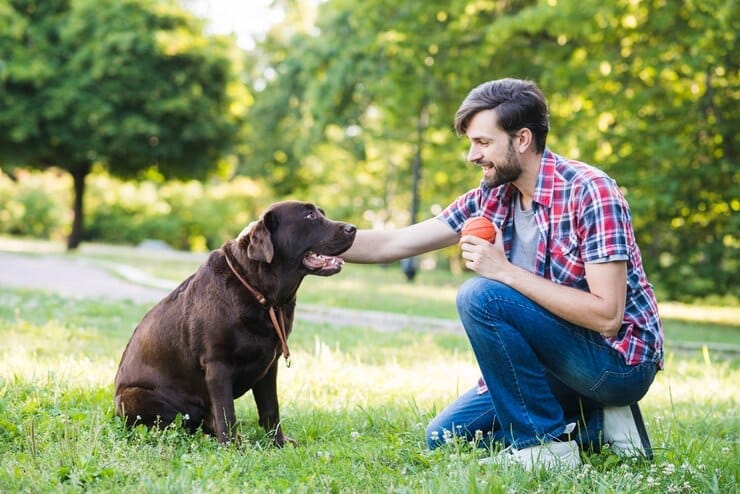There’s no denying that dogs with jobs are some of the hardest working creatures on our planet. Search and rescue dogs are no exception. In fact, human lives depend on these amazing canines who save lives and find the lost. In order to fully appreciate the depth of risk and dedication these dogs exude, you’ll want to learn about the history of these daring dog and what they go through to become fearless heroes.
The Hidden History of Search and Rescue Hounds
While working dogs have kept our cattle in line and our sheep safe for centuries, we’ve relied on our dogs’ fine-tuned noses and well-trained canines for over three hundred years to perform searches and rescues.
People first trained St. Bernard’s in the Swiss Alps to search for people who got lost in blizzards. The most infamous of these amazing dogs was named Barry. Barry saved somewhere between 40 and 100 people from freezing to death two hundred years ago. Barry is such a fixture in Swiss culture that the Bern Natural History Museum keeps his body on display to celebrate his achievements.
Search and rescue canines didn’t just brave the snow and altitude, they also faced bullets during both world wars. Many valiant dogs risked their lives alongside human soldiers in World War I and II. During the first World War, the English trained Doberman Pinschers, German Shepherds, and terriers as sentry dogs, casualty dogs, and as pest control. Sentry dogs barked or growled if the enemy approached to wake sleeping troops and warn them of the danger. Casualty dogs ran out into the line of fire to bring medicine to wounded men.
The conditions of war required soldiers to live the trenches. Unfortunately, rats took up residence beside them. Luckily, terriers were happy to perform a bit of pest control. They made it their mission to catch the rodents to keep them from bothering the weary soldiers.
By the time World War II hit, the U.S. Department of Defense realized the value dogs could have in the war effort. They trained messenger dogs, their own set of sentry dogs, and sled dogs. In fact, at the Battle of the Bulge, when American troops were left stranded in the dense snow, Colonel Norman Vaughan called in 200 sled dogs to help get medicine and sleds to the wounded troops. The snow was so dense that the dogs could not get to the men in need. So, Colonel Vaughan suggested they drop the dogs in. And lo and behold, America had its own paratrooper dogs!
After the wars, Americans realized that our best friends could and should serve a purpose beyond keeping us company—they could keep us safe.
In the Pacific Northwest, we started to use search dogs to smell out those that went missing in the vast wilderness. In 1965, search and rescue dogs successfully found their first missing person, a 14-year-old. The boy had been missing for hours, but it took the search dogs only twenty minutes to find him! From this time on, American search and rescue teams have utilized dogs’ profound ability to sniff out missing people and those that have passed.

The Day-to-Day Life of a Search and Rescue Dog
Search and rescue isn’t a typical nine to five. These dogs work hard day or night to find lost children, missing Alzheimer’s patients, skiers and snowboarders buried by avalanches, survivors trapped in collapsed buildings, and drowning victims. They also help investigate crime scenes.
There are two types of search and rescue dogs: tracking dogs and air-scent dogs. Both play vital roles in keeping us safe. Tracking dogs keep their noses to the ground and can smell human skin particles well enough to follow a trail where a person had walked. Air-scent dogs keep their snouts to the sky where they can sniff out human scent in the air.
Tracking dogs get to work when the search team has a starting point. You’ve probably seen one of these in a movie. The team gives the dog a shirt or item to sniff, then it takes off into the woods following a scent trail. Air-scent dogs pull scents from the wind. They follow the aroma as it gets more and more concentrated.
Air-scent dogs frequently work with their team to find the remains of people who have passed away. They can discover trace amounts of blood or a fingernail clipping.
Air-scent dogs don’t just find people lost in the wilderness, they ride along on boats to search for drowning victims. They can detect skin cells and gasses that rise to the surface. This allows them to find bodies that are completely underwater! These amazing sniffers can also find people trapped beneath 15 feet of snow. They also locate evidence at crime scenes.
Finding people that survive urban disasters is the most difficult job a search and rescue dog performs. These courageous canines responded to the 1995 Oklahoma City bombing and the World Trade Centers in 2001. The dogs on these missions struggled to find live bodies. Many of these amazing dogs located victims that had passed and felt discouraged that they couldn’t locate any living victims. Their handlers and on-site firefighters felt so bad for the disheartened dogs, that they hid in the rubble. This gave the dogs the opportunity to feel some sense of success.
These dogs are some of the most talented and dedicated heroes we have. They work tirelessly to help save lives and locate victims’ bodies to be returned to their loved ones.

What Training Goes into Becoming a Search and Rescue Dog?
Dogs and their handlers go through meticulous and rigorous training to be eligible to help with search and rescue missions. This training puts a dog’s ability to the test. Search and rescue training tests a pup’s physical ability, endurance, agility, intellect, and determination. Only the toughest, smartest, most determined dogs make it through successfully.
Search and rescue training usually unfolds in several phases. While there are many recognized methods, you can get a preliminary understanding by learning about what it takes to train a tracking dog.
· Step 1: The dog walks on a harness with a long leash (20 to 30 feet long). The dog begins to recognize this harness as its work uniform and gets into his worktime mindset.
Then, the handler and his or her team creates a line of treats that lead to an area that has a particular human scent. The dog sniffs a shirt or hat with the same scent and is then commanded to “find.” The dog follows the scent trail and treats to the area. When the pupper gets there, she receives praise and rewards. Then the dog repeats this all over in different locations.
· Step 2: The handler uses fewer and fewer treats while the trail becomes longer and longer. Then, the scent area is replaced with a ‘victim,’ a person who hides from the dog.
· Step 3: The trail become curvier and lengthens even more.
· Step 4: The treats completely disappear and the trail is extended to take the dog about 10 minutes to find the victim. During this step, the victim may be someone the dog has never met.
· Step 5: This one is super cool! This is the distraction step. The victim and another person walk alongside one another, then split off. The tracking dog has to continue on the original victim’s path and ignore the other person’s.
· Training continues: After a dog can successfully follow a victim even with distractions, then the pup will be tasked with a trail that is over a day old and 2 miles long!
Search and rescue dogs need to be able to climb up a ladder, through a tunnel, and jump over hurdles.
Eventually, the dogs must take and pass a certification test.

Final Thoughts
The amazing lives of search and rescue dogs offer many reasons to admire these talented dogs! If you’ve considered training your dog to assist in the effort of saving lives, you should go for it. Search and rescue dogs find their work incredibly rewarding. You can even use a Fi collar to track where your dog’s job will take him. You’ll be amazed by what your dog can accomplish with training, patience, and persistence.
If you’re interested in training your dog to be a search and rescue canine hero, you can contact:
· Search and Rescue Dogs of the United States (SARUS)
· FEMA’s Urban Search and Rescue Certification
· National Search Dog Alliance
· National Association of Search and Rescue (for handlers and dogs)


